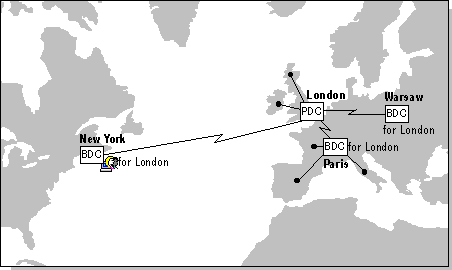
The two most important location considerations are where to locate the BDCs that will act as account logon servers and how to plan account-synchronization traffic across wide area network (WAN) links. If your WAN speed or bandwidth is low, you will want users to log on at a local BDC.
The next consideration is whether your networked organization is in one site or in several sites, connected by WAN links. A site is a well-connected LAN and may communicate by fast links, such as bridges and routers, but not by asynchronous WAN links, such as T1, 56K, or ISDN. Sites generally correspond to physical locations, such as Seattle, Paris, and New York.
The physical distribution of BDCs is determined by several factors: line speed, link reliability, administrative access, protocol, user-authentication requirements, the number of users to be supported at a site, and locally available resources.
The diagram below shows part of a network topology that one of these domains services. The networked hub sites in London, Paris, and Warsaw, which all belong to a European domain.

Figure 2.9 Locating domain controllers
The European PDC is in London, which is the network's main hub to Europe. The European PDC replicates to the BDCs at each site, including New York.